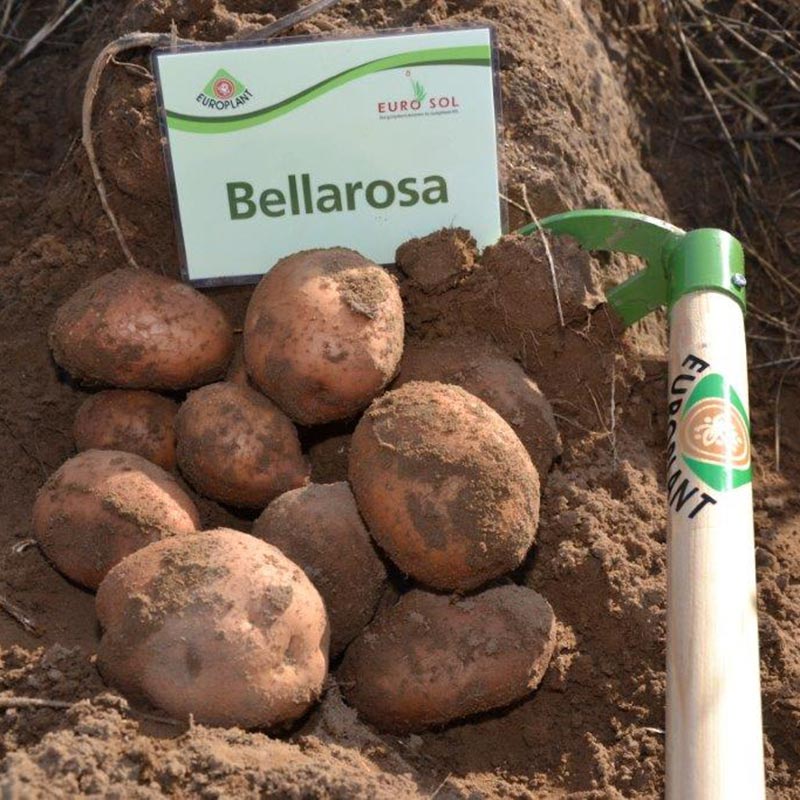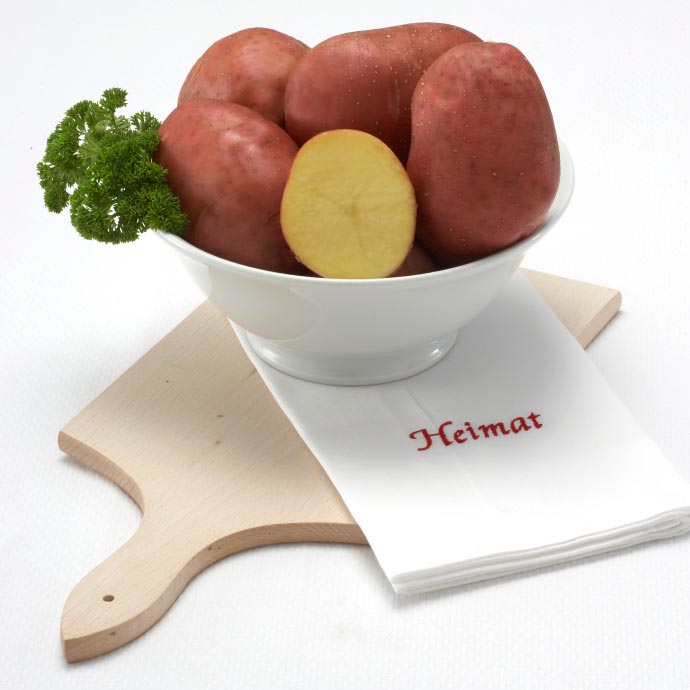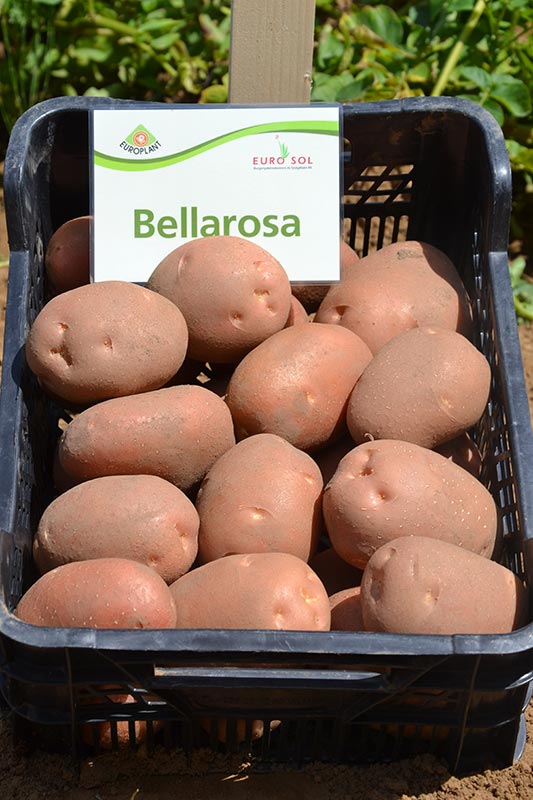Potato seed tuber "Bellarosa" 50 pcs
BELLAROSA - very early, rosy-skinned table potatoes
Introduction to the Bellarosa potato:
- early, abundant yield
- large tubers
- robust, drought tolerant
- resistant to tuber bruising
Bellarosa potatoes are hardy, resistant to hardiness, resistant to hardiness:
Soil requirements:
Bellarosa has low to medium soil requirements. Bellarosa is highly adaptable and grows well in a wide range of environmental and climatic conditions. However, Bellarosa should preferably be grown in soils with good agricultural conditions. Bellarosa tolerates heat and drought well, but a steady supply of nutrients and water is preferable. Soil with a high risk of tuber spot (internal iron stains) should be avoided, especially if no measures are taken to prevent this quality defect in these areas.
Water requirements:
Good drought tolerance, resistant to tuber blight.
Tuber:
Bellarosa produces large, pink-skinned tubers. The tuber maturation rate is medium and the recommended planting density is about 46,000 t/ha. Tubers intended for seed potatoes are generally recommended to be treated against Rhizoctonia solani.
Susceptibility, resistance:
Bellarosa is slightly sensitive to the herbicide Metribuzine (Sencor, etc.). Higher doses or post-emergence applications are not recommended. Pre-routine treatment for potato blight is recommended.
Bellarosa - growing suggestions
Bellarosa is a very early maturing, rosy-skinned, quality table potato with a plentiful market crop. The tubers have a lightly netted skin. Bellarosa stands out for its strong foliage, very early growth of larger tubers, very early skin firming and early harvestability.
Planting
Bellarosa is generally fast growing if the seed tubers and soil are in good condition. Well prepared, pre-sprouted seed potatoes can usually be planted early. Seed potatoes that have not been pre-sprouted should be planted in soil with a temperature above 8°C. Bellarosa has a medium to low tuber setting rate. A planting density of 46,000 heads/ha is recommended for growing table potatoes suitable for packing (seed tuber size 35/55 mm). Planting density may vary according to the planned harvest time and tuber size. Planting 55/60 mm tubers should be considered to increase the quantity of tubers produced and to obtain a suitable grading for packaging. For experienced professionals, the following practices may be a suitable option:
Specially recommended for increasing yield:
Depending on the method of marketing, increased tuber tying of seed tubers may be beneficial. This can be increased by breaking apical dominance and/or increasing physiological age.
Breaking apical dominance can be achieved by removing (breaking off) the first (apical) sprout(s). After breaking off the germ, the tuber germinates again from several buds (eyes). Warning: breaking off the germ causes a wound which is very susceptible to fungal and bacterial infections! This method should only be carried out before planting healthy, vigorous seed potatoes and drying must be ensured to prevent plant health problems.
Late planting:
Late planting also increases the physiological age.Warning: these steps are professionally challenging and should only be used with great care! If in doubt, skip them!
Nutrient replenishment:
Bellarosa absorbs nitrogen with high efficiency; the rate of nitrogen fertilisation can be slightly reduced (by about 20-30 % compared to the local average). In general, a nitrogen application rate of about 120 kg/ha (including the Nmin nitrogen content of the soil) is sufficient to achieve maximum yield. Excessive nitrogen application is the presumed cause of scattered tuber quality problems. If necessary, micronutrients (mainly boron) can be added by supplementary foliar fertilisation to control tuber defects, although there is no clear scientific evidence of its effectiveness.
A well balanced supply of potassium is necessary to ensure tuber quality. In soils with medium potassium content, 200 - 240 kg K2O/haof fertiliser can be applied to Bellarosa to meet its needs.
Plant protection:
Preventive treatment of seed tubers is generally recommendedRhizoctonia solani(active ingredients e.g. pencycuron, tolclofos-methyl, fluotolanil, fludioxonil) to ensure high product quality and a plentiful marketable crop.
Bellarosa is slightly sensitive to the herbicide metribuzin (Sencor®, etc.). Pre-emergence applications are usually tolerated without problems. Post-emergence applications may cause side effects on the plant (at high doses, under unfavourable environmental conditions). Post-emergence treatments should be applied very carefully, under favourable environmental conditions (not immediately after rain, plants should have a stable waxy layer) and, if possible, at reduced rates.
Although Bellarosa has a fairly high level of resistance, potato failure (Phytophthora infestans) should be prevented by regular spraying. If possible, chemical control of potato cyst nematodes should be initiated in response to a warning from the local potato cyst nematode early warning system. If such a warning system is not available, preventive spraying should be carried out shortly before the end of the baking season (leaf closure) with appropriate fungicides. If the moisture content at plant emergence is high, especially in clay soils, control of potato late blight should be started earlier to avoid primary stem infection. In these cases, preferably use systemic active substances (metalaxyl-m, mefenoxam, propamocarb). The further spray plan (active substances, method, intervals) can be adapted to the weather conditions and the risk of infection.
Harvest
Deworming is recommended to facilitate harvesting and to ensure high product quality, however, sudden damping-off of plants with green and vigorous foliage should be avoided to prevent quality defects of tubers caused by growth shock. Where possible, de-pollination should be carried out by successive partial methods and/or with slow-acting active substances (e.g. glufosinate-ammonium [Basta®, Liberty®, Finale®], carfentrazone [Shark®, Spotlight®], piraflufen [Quickdown®]). In general, harvesting should be carried out with care. If harvesting is done by combine harvester, soil temperature should not be less than 12°C. Careful handling and well-applied aeration and drying are beneficial to ensure good quality tubers.
| Greutate: | 1.1 kg |
|---|---|
| Lăţime: | 200 mm |
| Înălţime: | 155 mm |
| Lungime: | 135 mm |
| Cultură de plante: | Legume |
| Disponibilitatea produsului: | 1-4 zile |
| Unitate de vânzare de bază: | buc |
Autentificare
Autentificare


